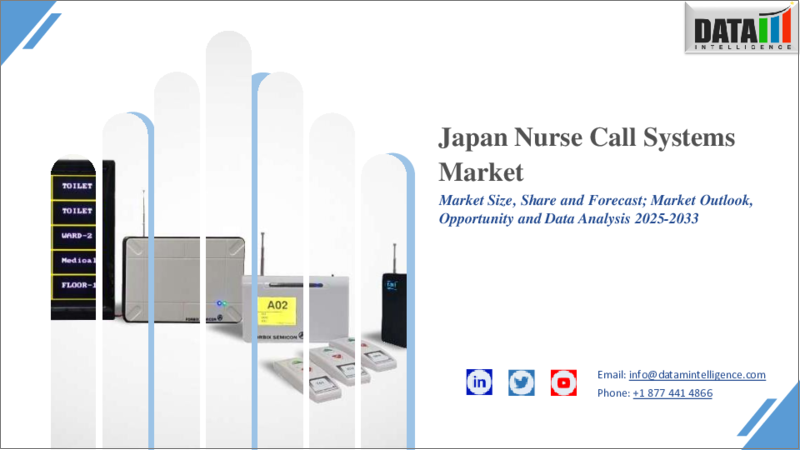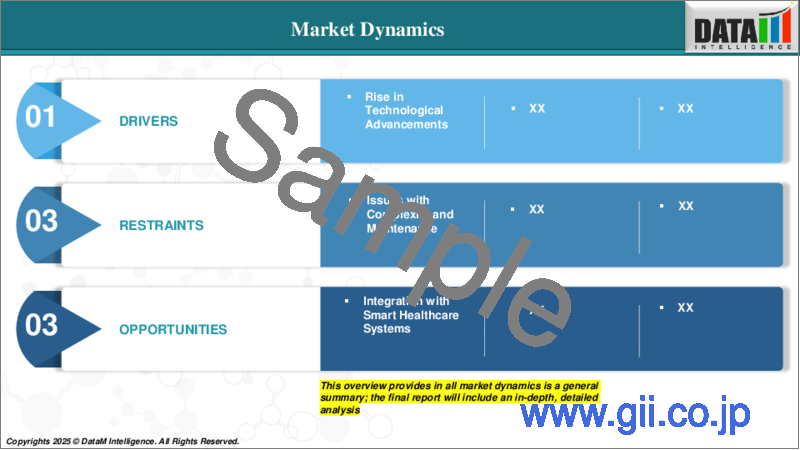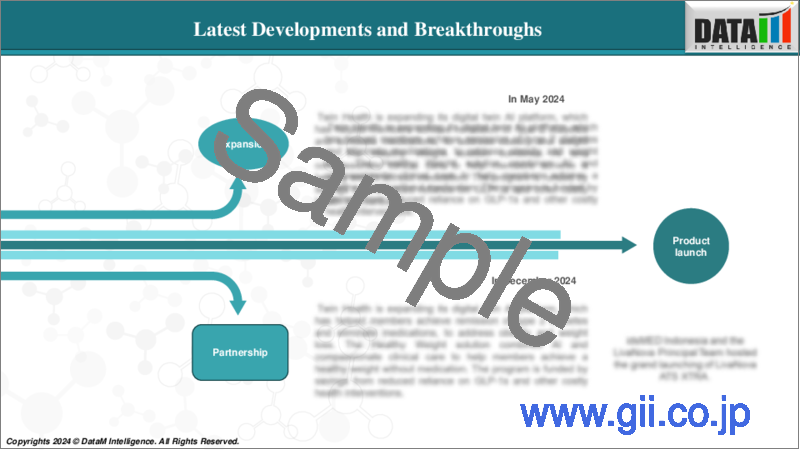|
|
市場調査レポート
商品コード
1666192
日本のナースコールシステム市場:2025年~2033年Japan Nurse Call Systems Market - 2025-2033 |
||||||
カスタマイズ可能
適宜更新あり
|
|||||||
| 日本のナースコールシステム市場:2025年~2033年 |
|
出版日: 2025年02月24日
発行: DataM Intelligence
ページ情報: 英文 117 Pages
納期: 即日から翌営業日
|
- 全表示
- 概要
- 目次
日本のナースコールシステム市場は、2024年に9,880万米ドルに達し、2033年には3億1,420万米ドルに達すると予測され、予測期間2025-2033年のCAGRは13.8%で成長する見込みです。
高齢化の進展は、日本のナースコールシステム市場の成長を大きく牽引しており、予測期間中も市場を牽引すると予測されます。2023年9月時点で、日本の65歳以上の高齢者は推定3,623万人となっています。総人口に占める割合は2022年から0.1ポイント上昇し、過去最高の29.1%に達し、その割合は世界で最も高く、2040年には36%に達するとの推計もあります。日本では高齢者人口が急増しており、特に介護や介助を必要とする高齢者の割合が高いです。
介護を必要とする高齢者の増加により、介護施設、老人ホーム、ヘルスケアサービスの需要が高まっています。ナースコールシステムは、これらの施設において、患者、特に認知症や運動能力の低下した患者がヘルスケアスタッフに自分のニーズを簡単に伝えられるようにするために不可欠です。例えば、日本の高齢者介護施設では、転倒検知システムを備えたナースコールシステムの需要が高くなっています。高齢の入居者は転倒することが多く、タイムリーな援助を確保し、重大な怪我を防ぐために迅速なアラートが必要だからです。
日本政府は、高齢者の介護費用を賄う「介護保険」制度など、高齢者介護の質の向上を目指した政策を打ち出しています。高齢者介護施設の近代化に対する奨励金や助成金には、ナースコールシステムなどの高度介護システムの要件が含まれていることが多いです。例えば、介護保険法に基づき、多くのケアハウスや介護施設は、規制に準拠し、高齢者ケアの質を高めるため、無線ナースコールシステムを導入しています。
技術の複雑さとメンテナンスは、日本におけるナースコールシステム(NCS)市場の成長を妨げる重要な課題です。先進的なナースコールシステムは多くの利点を提供する一方で、設置、運用、継続的なメンテナンスの面で複雑であるため、ヘルスケアプロバイダーはこれらのシステムの採用やアップグレードを思いとどまる可能性があります。
最新のNCS、特にワイヤレス、IoTとの統合、電子カルテ(EHR)のような他のヘルスケアシステムとの接続が可能なNCSは、設置が複雑な場合があります。既存の病院や施設のインフラとの統合には、慎重な計画と潜在的に高価な改造が必要です。ナースコールシステムが最適に機能するためには、継続的なメンテナンスと定期的な更新が必要です。これらのシステムの保守、ソフトウェアの更新、およびハードウェア・コンポーネントの交換にかかる費用は、特に予算が限られている施設や技術的リソースの少ない施設では、経済的負担となる場合があります。
当レポートでは、日本のナースコールシステム市場について調査し、市場の概要とともに、製品タイプ別、接続性別、用途別、エンドユーザー別、地域別動向、競合情勢、および市場に参入する企業のプロファイルなどを提供しています。
目次
第1章 市場のイントロダクションと範囲
第2章 エグゼクティブの洞察と重要なポイント
第3章 市場力学
- 影響要因
- 促進要因
- 抑制要因
- 機会
- 影響分析
第4章 戦略的洞察と業界の展望
- 市場のリーダーと先駆者
- CXOの視点
- 最新の開発とブレークスルー
- ケーススタディ/進行中の調査
- 規制と償還の情勢
- ポーターのファイブフォース分析
- サプライチェーン分析
- SWOT分析
- アンメットニーズとギャップ
- 市場参入と拡大のための推奨戦略
- シナリオ分析ベストケース、ベースケース、ワーストケースの予測
- 価格分析と価格動向
- キーオピニオンリーダー
第5章 ナースコールシステム市場、製品タイプ別
- 統合通信システム
- ボタンシステム
- モバイルシステム
- インターホンシステム
第6章 ナースコールシステム市場、接続性別
- 有線
- 無線
第7章 ナースコールシステム市場、用途別
- 緊急医療アラーム
- 徘徊管理
- ワークフローの最適化
- 転倒検知と予防
- その他
第8章 ナースコールシステム市場、エンドユーザー別
- 病院
- 介護施設・居住型介護施設
- 在宅ケア
- 長期介護施設
- 専門クリニック
- その他
第9章 競合情勢と市場ポジショニング
第10章 企業プロファイル
- CARECOM CO., LTD.
- Yarward Electronics Co., Ltd.
- Caretronic
- Baxter International Inc.
- Ascom
- Jpnovations Solutions Pvt Ltd.
- AIPHONE CO., LTD.
- TekTone
第11章 仮定と調査手法
第12章 付録
The Japan nurse call systems market reached US$ 98.8 million in 2024 and is expected to reach US$ 314.2 million by 2033, growing at a CAGR of 13.8% during the forecast period 2025-2033.
Nurse call systems are communication technologies designed to allow patients to alert healthcare providers, such as nurses or caregivers when they need assistance. These systems are crucial in healthcare environments like hospitals, nursing homes, assisted living facilities and other patient care settings where timely communication between patients and staff is essential.
The demand for nurse call systems in Japan is primarily driven by the country's aging population, the need for improved patient care and safety, government support for healthcare infrastructure, and the integration of new technologies like IoT and wireless communication. As Japan continues to modernize its healthcare system and prioritize patient-centered care, the market for nurse call systems is expected to grow significantly. The increasing use of wireless and mobile-enabled systems, along with the adoption of advanced features like fall detection and emergency alerts, reflects Japan's commitment to improving healthcare quality and efficiency.
Market Dynamics: Drivers & Restraints
Rising Aging Population
The rising aging population is significantly driving the growth of the Japan nurse call systems market and is expected to drive the market over the forecast period. An estimated 36.23 million people in Japan were aged 65 or older as of September 2023. The percentage of the total population rose to a record 29.1 percent, up 0.1 points from 2022, the highest proportion in the world, with estimates suggesting it will reach 36% by 2040. The elderly population in Japan is growing rapidly, with a particularly high percentage of elderly individuals requiring long-term care or assistance.
The rising number of elderly people in need of care increases the demand for long-term care facilities, nursing homes, and healthcare services. Nurse call systems are essential in these facilities to ensure that patients, particularly those with conditions like dementia or limited mobility, can easily communicate their needs to healthcare staff. For instance, in Japan's elderly care homes, nurse call systems with fall detection systems are in high demand, as elderly residents often experience falls and quick alerts are needed to ensure timely assistance and prevent serious injury.
Japan's government has set policies aimed at improving the quality of elderly care, including the "Long-Term Care Insurance" system, which covers care expenses for elderly individuals. Incentives and funding for modernizing elderly care facilities often include requirements for advanced care systems, such as nurse call systems. For instance, under the Long-Term Care Insurance Act, many care homes and nursing facilities have implemented wireless nurse call systems to comply with regulations and enhance the quality of care for the elderly.
Technological Complexity and Maintenance
Technological complexity and maintenance are significant challenges hampering the growth of the Nurse Call Systems (NCS) market in Japan. While advanced NCS systems offer many benefits, their complexity in terms of installation, operation and ongoing maintenance can discourage healthcare providers from adopting or upgrading these systems.
Modern NCS, especially those that are wireless, integrated with IoT or connected with other healthcare systems like electronic health records (EHR), can be complex to install. The integration with existing hospital or facility infrastructure requires careful planning and potentially expensive retrofitting. Nurse call systems require continuous maintenance and periodic updates to ensure that they function optimally. The cost of servicing these systems, updating software and replacing hardware components can be a financial burden, particularly in facilities with limited budgets or fewer technical resources.
Modern NCS often require specialized knowledge to operate, especially when integrated with other hospital management systems or IoT devices. The need for ongoing training for healthcare staff to ensure effective use of the systems adds to the complexity and cost of implementation. For instance, in elderly care homes across Japan, some facilities have reported challenges in training caregivers to operate new Nurse Call Systems, especially those that use mobile apps or more complex features. This issue leads to slow adoption and, in some cases, inefficient utilization of the systems.
Segment Analysis
The Japan nurse call systems market is segmented based on product type, connectivity, application and end-user.
Product Type:
The integrated communication systems segment is expected to dominate the Japan nurse call systems market share
Integrated communication systems allow for real-time communication between patients, healthcare staff and various hospital departments, leading to faster response times, improved patient safety and better workflow management. The growing adoption of Electronic Health Records (EHR) and other digital healthcare systems in Japan's hospitals and nursing homes is pushing the demand for integrated nurse call systems. These systems provide instant access to patient data, which improves decision-making and enables healthcare professionals to respond more effectively.
For instance, in Keio University Hospital, an integrated nurse call system is connected with EHR systems, allowing nurses to receive alerts not only about patient calls but also about patient medical histories and real-time monitoring data. This integration ensures that healthcare providers can make informed decisions and respond quickly in emergency situations.
Integrated nurse call systems that connect with other hospital systems (such as lighting, HVAC, or monitoring systems) improve patient care by enabling a more seamless and responsive environment. For instance, these systems can automatically adjust room conditions or inform staff about critical situations.
In elderly care homes across Japan, integrated communication systems are used to link NCS with environmental controls, such as adjusting room temperature or lighting based on patient preferences or needs. This integration improves the patient experience, as residents feel their care is more personalized and responsive.
Competitive Landscape
The major market players in the nurse call systems market include CARECOM CO., LTD., Yarward Electronics Co., Ltd., Caretronic, Baxter International Inc., Ascom, Jpnovations Solutions Pvt Ltd., AIPHONE CO., LTD., TekTone and among others.
Why Purchase the Report?
- Pipeline & Innovations: Reviews ongoing clinical trials, product pipelines, and forecasts upcoming advancements in medical devices and pharmaceuticals.
- Product Performance & Market Positioning: Analyzes product performance, market positioning, and growth potential to optimize strategies.
- Real-World Evidence: Integrates patient feedback and data into product development for improved outcomes.
- Physician Preferences & Health System Impact: Examines healthcare provider behaviors and the impact of health system mergers on adoption strategies.
- Market Updates & Industry Changes: Covers recent regulatory changes, new policies, and emerging technologies.
- Competitive Strategies: Analyzes competitor strategies, market share, and emerging players.
- Pricing & Market Access: Reviews pricing models, reimbursement trends, and market access strategies.
- Market Entry & Expansion: Identifies optimal strategies for entering new markets and partnerships.
- Regional Growth & Investment: Highlights high-growth regions and investment opportunities.
- Supply Chain Optimization: Assesses supply chain risks and distribution strategies for efficient product delivery.
- Sustainability & Regulatory Impact: Focuses on eco-friendly practices and evolving regulations in healthcare.
- Post-market Surveillance: Uses post-market data to enhance product safety and access.
- Pharmacoeconomics & Value-Based Pricing: Analyzes the shift to value-based pricing and data-driven decision-making in R&D.
The Japan nurse call systems market report delivers a detailed analysis with 36 key tables, more than 34 visually impactful figures, and 117 pages of expert insights, providing a complete view of the market landscape.
Target Audience 2024
- Manufacturers: Pharmaceutical, Medical Device, Biotech Companies, Contract Manufacturers, Distributors, Hospitals.
- Regulatory & Policy: Compliance Officers, Government, Health Economists, Market Access Specialists.
- Technology & Innovation: AI/Robotics Providers, R&D Professionals, Clinical Trial Managers, Pharmacovigilance Experts.
- Investors: Healthcare Investors, Venture Fund Investors, Pharma Marketing & Sales.
- Consulting & Advisory: Healthcare Consultants, Industry Associations, Analysts.
- Supply Chain: Distribution and Supply Chain Managers.
- Consumers & Advocacy: Patients, Advocacy Groups, Insurance Companies.
- Academic & Research: Academic Institutions.
Table of Contents
1. Market Introduction and Scope
- 1.1. Objectives of the Report
- 1.2. Report Coverage & Definitions
- 1.3. Report Scope
2. Executive Insights and Key Takeaways
- 2.1. Market Highlights and Strategic Takeaways
- 2.2. Key Trends and Future Projections
- 2.3. Snippet by Product Type
- 2.4. Snippet by Connectivity
- 2.5. Snippet by Application
- 2.6. Snippet by End-User
3. Dynamics
- 3.1. Impacting Factors
- 3.1.1. Drivers
- 3.1.1.1. Rising Aging Population
- 3.1.2. Restraints
- 3.1.2.1. Technological Complexity and Maintenance
- 3.1.3. Opportunity
- 3.1.4. Impact Analysis
- 3.1.1. Drivers
4. Strategic Insights and Industry Outlook
- 4.1. Market Leaders and Pioneers
- 4.1.1. Emerging Pioneers and Prominent Players
- 4.1.2. Established leaders with largest selling Brand
- 4.1.3. Market leaders with established Product
- 4.2. CXO Perspectives
- 4.3. Latest Developments and Breakthroughs
- 4.4. Case Studies/Ongoing Research
- 4.5. Regulatory and Reimbursement Landscape
- 4.6. Porter's Five Force Analysis
- 4.7. Supply Chain Analysis
- 4.8. SWOT Analysis
- 4.9. Unmet Needs and Gaps
- 4.10. Recommended Strategies for Market Entry and Expansion
- 4.11. Scenario Analysis: Best-Case, Base-Case, and Worst-Case Forecasts
- 4.12. Pricing Analysis and Price Dynamics
- 4.13. Key Opinion Leaders
5. Nurse Call Systems Market, By Product Type
- 5.1. Introduction
- 5.1.1. Market Size Analysis and Y-o-Y Growth Analysis (%), By Product Type
- 5.1.2. Market Attractiveness Index, By Product Type
- 5.2. Integrated Communication Systems*
- 5.2.1. Introduction
- 5.2.2. Market Size Analysis and Y-o-Y Growth Analysis (%)
- 5.3. Button Systems
- 5.4. Mobile Systems
- 5.5. Intercom Systems
6. Nurse Call Systems Market, By Connectivity
- 6.1. Introduction
- 6.1.1. Market Size Analysis and Y-o-Y Growth Analysis (%), By Connectivity
- 6.1.2. Market Attractiveness Index, By Connectivity
- 6.2. Wired*
- 6.2.1. Introduction
- 6.2.2. Market Size Analysis and Y-o-Y Growth Analysis (%)
- 6.3. Wireless
7. Nurse Call Systems Market, By Application
- 7.1. Introduction
- 7.1.1. Market Size Analysis and Y-o-Y Growth Analysis (%), By Application
- 7.1.2. Market Attractiveness Index, By Application
- 7.2. Emergency Medical Alarms*
- 7.2.1. Introduction
- 7.2.2. Market Size Analysis and Y-o-Y Growth Analysis (%)
- 7.3. Wanderer Control
- 7.4. Workflow Optimization
- 7.5. Fall Detection & Prevention
- 7.6. Others
8. Nurse Call Systems Market, By End-User
- 8.1. Introduction
- 8.1.1. Market Size Analysis and Y-o-Y Growth Analysis (%), By End-User
- 8.1.2. Market Attractiveness Index, By End-User
- 8.2. Hospitals*
- 8.2.1. Introduction
- 8.2.2. Market Size Analysis and Y-o-Y Growth Analysis (%)
- 8.3. Nursing and Assisted Living Centers
- 8.4. Home Care Settings
- 8.5. Long-term Care Facilities
- 8.6. Specialty Clinics
- 8.7. Others
9. Competitive Landscape and Market Positioning
- 9.1. Competitive Overview and Key Market Players
- 9.2. Market Share Analysis and Positioning Matrix
- 9.3. Strategic Partnerships, Mergers & Acquisitions
- 9.4. Key Developments in Product Portfolios and Innovations
- 9.5. Company Benchmarking
10. Company Profiles
- 10.1. CARECOM CO., LTD.*
- 10.1.1. Company Overview
- 10.1.2. Product Portfolio and Description
- 10.1.3. Financial Overview
- 10.1.4. Key Developments
- 10.1.5. SWOT Analysis
- 10.2. Yarward Electronics Co., Ltd.
- 10.3. Caretronic
- 10.4. Baxter International Inc.
- 10.5. Ascom
- 10.6. Jpnovations Solutions Pvt Ltd.
- 10.7. AIPHONE CO., LTD.
- 10.8. TekTone
LIST NOT EXHAUSTIVE
11. Assumption and Research Methodology
- 11.1. Data Collection Methods
- 11.2. Data Triangulation
- 11.3. Forecasting Techniques
- 11.4. Data Verification and Validation
12. Appendix
- 12.1. About Us and Services
- 12.2. Contact Us






